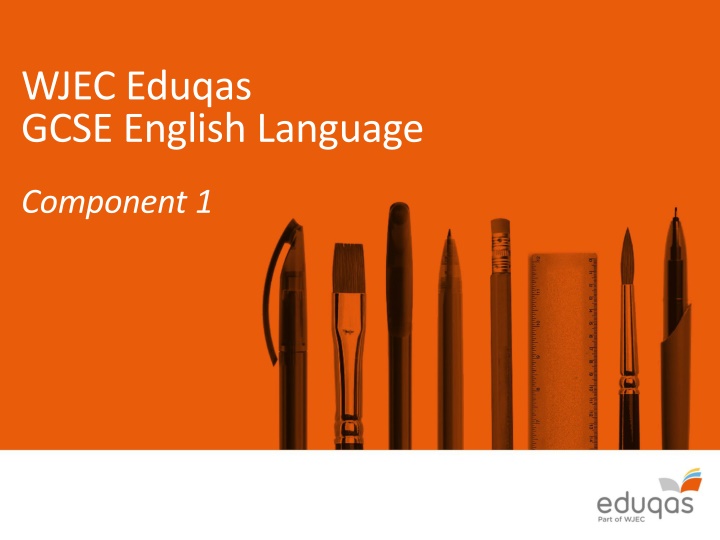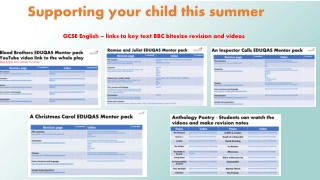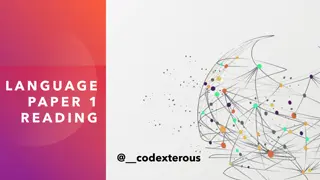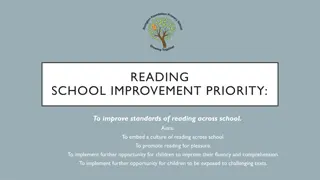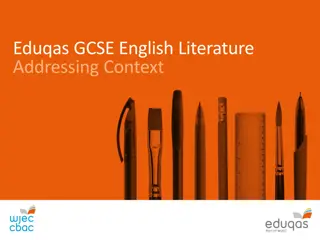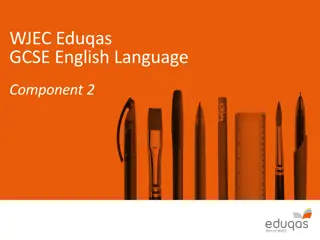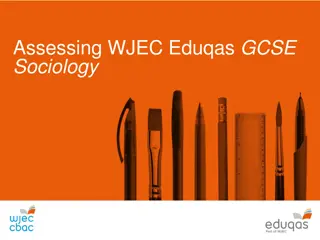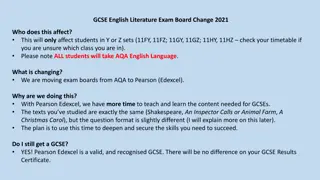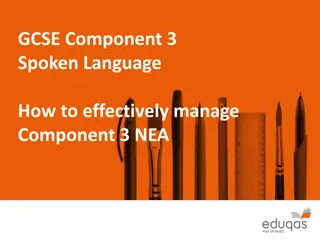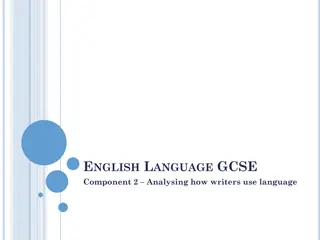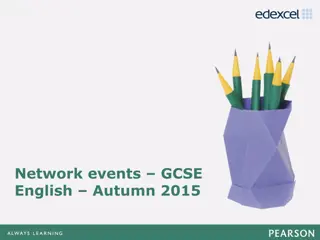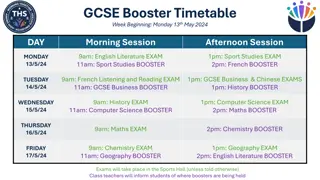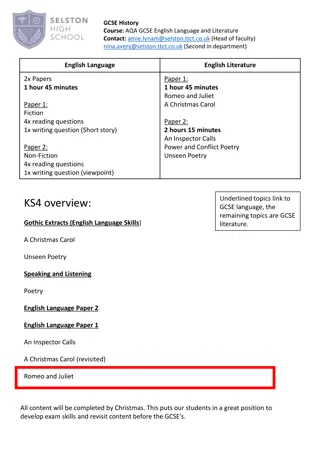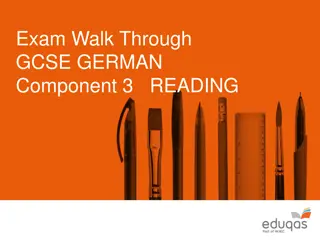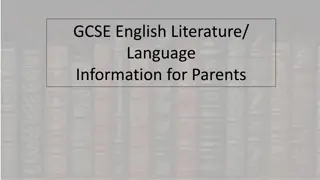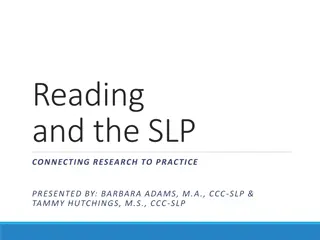WJEC Eduqas GCSE English Language Component 1 Assessment Objectives for Reading
Explore the assessment objectives for reading in WJEC Eduqas GCSE English Language Component 1, focusing on identifying and interpreting information, analyzing language and structure, evaluating texts critically, and key messages for exam responses. Understand how to approach questions, track text, use relevant evidence, and avoid common errors to achieve better results in the assessment.
Download Presentation

Please find below an Image/Link to download the presentation.
The content on the website is provided AS IS for your information and personal use only. It may not be sold, licensed, or shared on other websites without obtaining consent from the author.If you encounter any issues during the download, it is possible that the publisher has removed the file from their server.
You are allowed to download the files provided on this website for personal or commercial use, subject to the condition that they are used lawfully. All files are the property of their respective owners.
The content on the website is provided AS IS for your information and personal use only. It may not be sold, licensed, or shared on other websites without obtaining consent from the author.
E N D
Presentation Transcript
WJEC Eduqas GCSE English Language Component 1
COMPONENT 1 ASSESSMENT OBJECTIVES READING Identify and interpret explicit and implicit information and ideas (assessed in Question 1) AO1 Explain, comment on and analyse how writers use language and structure to achieve effects and influence readers, using relevant subject terminology to support their views (assessed in Questions 2, 3 and 4) Evaluate texts critically and support this with appropriate textual references (assessed in Question 5) AO2 AO4 Each Reading question targets ONE assessment objective.
Principal Examiners Key Messages Reading Responses Read the questions carefully Bullet points are fine for Q01 as long as the answers make sense Remember the mark tariff per question and plan time accordingly (don t spend too long on the 5 mark questions) Don t go outside the lines indicated If bullet points are included as part of the question, take note of them
Principal Examiners Key Messages Reading Responses Continued Track through the section of text indicated Tracking the text can also help in understanding its structure Support points with appropriate and relevant evidence How a writer achieves effects is a matter of content as well as authorial devices Use of subject terminology should be relevant and support points made Avoid feature spotting or naming of the parts
WJEC Eduqas GCSE English Language Assessment in practice: Component 1
Question 0.4 AO2 Explain, comment on and analyse how writers use language and structure to achieve effects and influence readers, using relevant subject terminology to support their views.
Component 1 Assessment in Practice Question 0.4 Indicates that AO2 is being assessed How does the writer make these lines exciting and dramatic? You should write about: Candidates should look at events as well as language and structure in their response excitement and drama the effects on the reader You must refer to the language in the text to support your answer, using relevant subject terminology where appropriate. what happens in these lines to build excitement and drama the writer's use of language and structure to create [10 marks] A reminder to the candidates of the importance of selecting appropriate textual evidence to support points Any subject terminology used in a response should be relevant and not just feature spotting
Characteristics of a Successful Response The response only addresses the specified lines given in the question There are a range of relevant points Points are supported with appropriate evidence from the text Analysis of the writer s techniques is focused and coherent. Use of subject terminology is relevant and is embedded in the response
Areas for Improvement Points made do not always focus on the question asked The response drifts outside the specified lines Devices are spotted but little explanation of effect Range is limited for a 10 mark question Too much copying and describing rather than selection and analysis
Question 0.5 Evaluate texts critically and support this with appropriate textual references.
Component 1 Assessment in Practice Focus of question The writer uses the walk to Wreck Island to show a change in both Emma and Robbie. Indicates AO4 is being assessed How far do you agree with this view? [10 marks] Give own opinions keeping focus of question in mind You should write about: presented in these lines and in the passage as a whole how the writer has created these thoughts and feelings Evaluation of authorial method your thoughts and feelings about how Emma and Robbie are You must refer to the text to support your answer. Opinions should be supported with relevant textual evidence
Component 1 Assessment in Practice Read the three responses for Q0.5 Rank order them Put each response into a band
Characteristics of a Successful Response The response considers the whole passage Clear focus on the statement given Opinions are always supported with appropriate evidence from the text The response has a coherent stance Evaluation of authorial methods and how these methods have shaped opinions
Areas for Improvement Points made do not focus on the statement The range of points is limited to a small part of the text Opinions are not fully supported Opinions lack clarity of thought
Component 1 Example Question Stems AO1: Identify and interpret explicit and implicit information and ideas List five things you learn about List five reasons List five things [ ..] thinks/feels about AO2: Explain, comment on and analyse how writers use language and structure to achieve effects and influence readers, using relevant subject terminology to support their views How does the writer show ? How does the writer present ? What impressions does the writer create ? What impressions do you get of ? How does the writer make these lines tense/exciting/dramatic ?
Component 1 Example Question Stems AO4: Evaluate texts critically and support this with appropriate textual references Statement/Viewpoint/Quote followed by: How far do you agree with this view? To what extent do you agree with this view? Evaluate (e.g. the way a character is presented etc ) How successfully/effectively does the writer ?
COMPONENT 1 ASSESSMENT OBJECTIVES - WRITING WRITING (50% of the overall qualification) AO5 Communicate clearly, effectively, and imaginatively, selecting and adapting tone, style and register for different forms, purposes and audiences; Organise information and ideas, using structural and grammatical features to support coherence and cohesion of texts. AO6 Candidates must use a range of vocabulary and sentence structures for clarity, purpose and effect, with accurate spelling and punctuation. (This requirement constitutes 20% of the marks for the specification as a whole.)
Principal Examiners Key Messages Q1.1 Choice of titles worked well and gave candidates opportunities to write from personal experience or to create imaginative fiction Five/ten minutes spent planning the narrative is time well spent The narrative should be coherent - don t lose the plot Remember the word limit. Examiners don t count the number of words but narratives that fall short of the suggested minimum are under developed and self penalising Description within the narrative helps to develop character, setting etc. but a pure description will be self limiting as it will lack narrative plot and drive
Principal Examiners Key Messages Q1.1 no novellas - keep the timeline, number of characters and number of events manageable structure-importance of paragraphs organising a narrative to meet a fixed conclusion ( Write a story which ends: ) requires thought and planning. Candidates need to have a clear sense of where they are going if they opt for this task time should be allocated to check technical accuracy, especially commas, full stops, tenses and speech punctuation
COMPONENT 1: SECTION B - WRITING 24 marks are awarded for communication and organisation; 16 marks are awarded for vocabulary, sentence structure, spelling and punctuation. Choice of titles (candidates choose one): Continue the following: It really wasn t the result I was looking for. Grandma. Write about a time when you had to go shopping with a relative. Write a story which ends: and I felt so sorry for myself. [40 marks]
Component 1 Assessment in Practice How could the opening of this narrative be used in the classroom to improve candidates narrative writing skills? It really wasn t the result I was looking for. I was having a photoshoot for a company that was attempting to sell old-style clothing. They suggested I should go to an old house to match the theme of this 19th century dressing. I was rather happy and was enjoying it all until I went through all the pictures and realised that all the photos were terrible. I couldn t decide wheather is my positioning, the outfit or the background. I came to the conclusion that it was the background, but to my suprise I noticed a lose brick in the background with some flowers growing out the back of it and I was intrigued by this.
Component 1 Assessment in Practice How could this narrative ending be used in the classroom to improve candidates narrative writing skills? My grandfather sat in the same spot for what seemed like hours and even my mother was beginning to get impatient. The various hues of tie sitting on the shelves in a myriad of colours seemed almost daunting. However, at last my grandfather raised an arm and pointed. That one, he said, with an air of complete certainty. I glanced at a tie with blue and gold stripes. Good choice, I murmured before reaching up and picking it off the shelf. I gave it to my mother and she went off to pay for it. Why that one? I asked. Good question, he replied. It reminds me of the sea and sun. I had not expected something so heartfelt from him, and especially while shopping.
Characteristics of a successful response The narrative clearly links to one of the specified titles The plot has a sense of purpose and direction Characterisation is developed and sustained The story engages the reader Spelling and punctuation is checked and basics are used consistently accurately The response is cohesive and makes sense The ending is convincing
Areas for Improvement Response isn t linked to one of the specified titles The plot is hard to follow and there is a lack of cohesion The structure of the narrative is uncertain There are too many characters with limited development The ending is abrupt and makes little sense Basic punctuation such as, full stops, commas and speech punctuation are missing or inaccurate Tenses are insecure
WJEC Eduqas GCSE English Language Component 2
COMPONENT 2 ASSESSMENT OBJECTIVES READING (assessed in Question 1 and 3) Select and synthesise evidence from different texts (assessed in Question 5) AO1 Identify and interpret explicit and implicit information and ideas AO2 Explain, comment on and analyse how writers use language and structure to achieve effects and influence readers, using relevant subject terminology to support their views (assessed in Question 2 ) AO3 Compare writers' ideas and perspectives, as well as how these are conveyed, across two or more texts (assessed in Question 6) AO4 Evaluate texts critically and support this with appropriate textual references (assessed in Question 4) Each Reading question targets ONE assessment objective.
Component 2 Reading: Principal Examiner s Key Messages Read the instructions at the start of each question carefully to avoid answering on the wrong text Don t lose marks in 1.1 and 1.3 by not reading the question properly Remember the mark tariff per question and plan time accordingly e.g. synthesis question is worth 4 marks and should be dealt with fairly quickly Keep the focus of the question firmly in mind Support points with appropriate evidence Use relevant terminology where AO2 is assessed. Avoid feature spotting
Question 1.4 Evaluate texts critically and support this with appropriate textual references
Component 2 Assessment in Practice Question 1.4 Indicates that AO4 is being assessed and that personal response and critical evaluation is required Focus of the question Pieter Sandrick gets across his feelings of increasing terror really well. How far do you agree with this statement? You should comment on: what he says how he says it [10] Opinions should be supported You must refer to the text to support your comments.
Characteristics of a successful response Focuses on the statement given in the question Tracks and selects the important details/comments made by the writer Supports opinions with textual evidence Clear evaluation based on a good range of evidence Clear point of view and clarity of thought Evaluation of authorial methods and how these methods have shaped opinions (aware of the text as a piece of non-fiction)
Areas for Improvement Lack of focus on the statement given in the question Unsupported opinions Lack of clear point of view Brief and limited response Stabbing at points rather than tracking the text Missing large parts of the text Limited comment on how the writer has helped shape opinions
Question 1.6 Compare writers' ideas and perspectives, as well as how these are conveyed, across two or more texts
Component 2 Assessment in Practice Question 1.6 Final reading question will always assess AO3 Both of these texts are about volcanoes that have erupted. Focus of question Compare: what the writers could see and hear of the erupting volcanoes how they get their experiences across to their readers Candidates need to compare content and authorial method You must use the text to support your comments and make it clear which text you are referring to. [10] Reminder of the importance of linking points to correct text
Exemplar 2 Both of the texts are about the volcanoes that have erupted but both texts have similarities and differences. In the text by Tom Robbins he says that when they got closer to the volcano he could see a plume of smoke which shows how quickly the reaction is of the volcano which is similar to Peter as he says that the volcano was completely covered in smoke . The next thing Robbins says is that what they saw was so beautiful that it is easy to forget about the danger . However, this is different to Sandrick as he says you could not see my hand before your eyes because of the `thick darkness` in the town which implies how bad the air was as they wouldn t have thought it was a nice thing to see. Another thing Robbins says is that the sound of the volcano is thrilling from the `low booms` which shows how he enjoyed listening to it erupting. This is different to Sandrick as he says the eruptions became deafening which is completely different. Overall, both texts have the differences and similarities but both texts are mainly different as Robbins enjoyed his experience and says it was a privilege to be there whereas Sandrick only talks about how horrible it was.
Characteristics of a successful response Identifies the focus of the question and makes points linked to it Bullet points are used to shape the response Points are supported with appropriate textual evidence Both texts are considered and it is clear which text is being referred to in the response Comparison of content is relevant and clear Authorial methods are compared for higher bands
Areas for Improvement General comparisons with no clear focus on task set The bullet points are not used to shape the response Points are not supported with appropriate textual evidence Coverage of texts is uneven, or just one text is considered Repetition of points Not clear which text is being referred to in the response
Component 2 Example Question Stems AO1: Identify and interpret explicit and implicit information and ideas Give one example List How many Give two details AO1: Select and synthesise evidence from different texts According to both writers Using information from both texts
Component 2 Example Question Stems AO2: Explain, comment on and analyse how writers use language and structure to achieve effects and influence readers, using relevant subject terminology to support their views How does the writer of the article/letter/report etc show ? How does the writer present ? How does the writer try to show AO3: Compare writers' ideas and perspectives, as well as how these are conveyed, across two or more texts Compare: What the writers say about How the writers get across The writers attitudes towards/views on
Component 2 Example Question Stems AO4: Evaluate texts critically and support this with appropriate textual references Statement/Viewpoint/Quote followed by: How far do you agree with this view? To what extent do you agree with this view? How successfully/effectively does the writer ? What do you think and feel about ?
Section B: Transactional/Persuasive Writing
COMPONENT 2 ASSESSMENT OBJECTIVES - WRITING WRITING (50% of the overall qualification) AO5 Communicate clearly, effectively, and imaginatively, selecting and adapting tone, style and register for different forms, purposes and audiences; Organise information and ideas, using structural and grammatical features to support coherence and cohesion of texts. AO6 Candidates must use a range of vocabulary and sentence structures for clarity, purpose and effect, with accurate spelling and punctuation. (This requirement must constitute 20% of the marks for the specification as a whole.)
Principal Examiners Key Messages Split time equally between the two tasks Aim for 300-400 words per task. Brief and/or limited responses will be self penalising Address the audience and purpose given in the task Adopt an appropriate tone for the task Practise writing in different formats e.g. letter (formal and informal), articles, reports, talks etc Format letters appropriately and include a suitable greeting and sign off Spend time checking basic punctuation and grammar Take time to plan and structure responses Depth and detail will help to develop convincing responses
Component 2 Assessment in Practice Question 2.1 A travel magazine is inviting readers to submit articles on places for a good day out for all the family. You decide to write about a place that you know well, where there is a lot to do for everyone in the family. Write your article. [20]
Comparative Judgement Read exemplars 1 and 2. Which exemplar is better? Why?
Characteristics of a successful response Clear understanding of the audience (the whole family in this instance) Clear understanding of purpose (informative and engaging) A range of specific details relating clearly to the task set to interest the reader Sustained piece (between 300-400 words) Overall control of spelling, punctuation and grammar
Areas for Improvement Not addressing the specified audience (or only part of the audience) Insecure understanding of purpose e.g. more advert than article Limited range of specific details Brief response below the recommended word limit Basic technical errors throughout the response Lack of paragraphs to organise the response
Useful Websites British Library https://www.bl.uk/ The British newspaper archive Englicious http://englicious.org/ Grammar and punctuation exercises Narrative writing Tes secondary English resources
